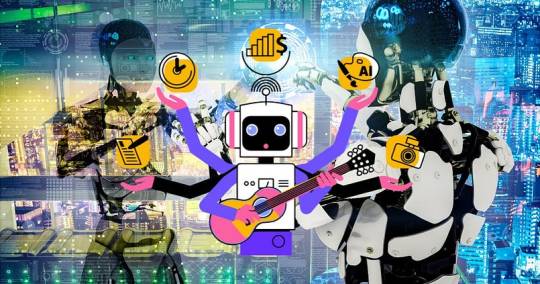Text
All AI Tools in One Place: 100% Free
Artificial Intelligence (AI) is transforming industries, driving innovation, and changing the way we live and work. From natural language processing to image recognition, AI tools have become invaluable in solving complex problems and automating mundane tasks. However, accessing high-quality AI tools often comes with a hefty price tag, creating barriers for individuals, startups, and small businesses. Imagine if you could access all these powerful tools in one place, entirely free of charge. This article explores the landscape of free AI tools available today, how they empower users, and where to find them.
The Power of AI Tools

AI tools leverage machine learning, deep learning, and other AI techniques to perform tasks that typically require human intelligence. These tasks include:
Data Analysis: Extracting insights from large datasets.
Text Generation: Producing coherent written content.
Image and Video Processing: Enhancing, editing, or analyzing multimedia.
Voice Recognition: Understanding and processing spoken language.
Automation: Streamlining repetitive tasks.
These tools enable users to work more efficiently, make informed decisions, and create innovative solutions to real-world problems.
The Need for Free AI Tools
While large corporations can afford expensive AI software, individuals and small enterprises often cannot. Free AI tools democratize access, fostering creativity and innovation across diverse fields. These tools help:
Students complete projects and learn AI fundamentals.
Entrepreneurs prototype ideas and develop products.
Researchers analyze data without budget constraints.
Freelancers enhance their offerings and improve productivity.
جميع أدوات الذكاء الاصطناعي في موقع واحد
Categories of Free AI Tools
1. Natural Language Processing (NLP)
NLP tools process and analyze textual data, enabling applications like chatbots, sentiment analysis, and language translation. Notable free tools include:
Hugging Face Transformers: A powerful library for building NLP models.
SpaCy: A free and open-source NLP library for tokenization, parsing, and named entity recognition.
Google Colab: Provides free access to Python notebooks with built-in support for NLP libraries.
2. Image and Video Processing
AI tools in this category help edit images, recognize objects, and even create art. Examples include:
DeepArt.io: Transform photos into artworks using neural networks.
Runway ML: Offers tools for video editing and machine learning-powered visual effects.
Pix2Pix: Generates realistic images from sketches or other input data.
3. Machine Learning Platforms
These platforms provide pre-built models and resources to train custom models:
Google TensorFlow: An open-source framework for machine learning and deep learning.
Microsoft Azure ML Studio (Free Tier): Offers a cloud-based environment for building, training, and deploying machine learning models.
IBM Watson Studio: Free tier provides access to AI tools and cloud resources.
4. Audio and Speech Processing
Tools in this category enable tasks like speech-to-text, voice synthesis, and sound analysis:
Audacity: An open-source audio editing tool with AI-powered noise reduction.
Mozilla DeepSpeech: A free speech-to-text engine.
VoiceAI: Generates synthetic voices and enhances audio quality.
5. Automation and Productivity
AI tools can automate repetitive tasks, saving time and effort:
Zapier (Free Plan): Connects apps to automate workflows.
IFTTT (If This Then That): Allows users to create automated tasks across various platforms.
UiPath Community Edition: Free robotic process automation (RPA) software.
6. Design and Creativity
Creative AI tools empower users to generate designs, videos, and even music:
Canva (Free Plan): Offers AI-powered design tools for creating presentations, posters, and social media graphics.
Soundraw: An AI music generator that allows users to create royalty-free tracks.
DALL-E: A tool from OpenAI that generates images from textual descriptions.
Benefits of Using Free AI Tools
1. Cost-Effectiveness
Free AI tools eliminate financial barriers, enabling users to experiment and innovate without the risk of significant investment.
2. Ease of Use
Many free AI tools come with user-friendly interfaces and extensive documentation, making them accessible even for beginners.
3. Scalability
Free tiers often provide enough resources for small projects, with options to scale up if needed.
4. Community Support
Open-source AI tools usually have active communities that offer support, share ideas, and contribute to the tool’s development.
Where to Find Free AI Tools
GitHub: A treasure trove of open-source AI projects and libraries.
AI Portals: Websites like Papers with Code and Awesome AI curate lists of free tools and resources.
Cloud Providers: Platforms like Google Cloud, AWS, and Microsoft Azure offer free tiers with access to AI services.
Online Forums: Communities on Reddit, Stack Overflow, and AI-focused Discord servers provide recommendations and tutorials.
How to Maximize the Potential of Free AI Tools
Stay Updated: Regularly check for updates and new features.
Leverage Tutorials: Use online courses, YouTube tutorials, and community forums to learn effectively.
Collaborate: Join online communities to share knowledge and collaborate on projects.
Experiment: Test different tools to find the ones that best suit your needs.
Challenges and Limitations
While free AI tools are powerful, they come with some limitations:
Limited Resources: Free tiers often have constraints on usage and performance.
Learning Curve: Some tools require a basic understanding of AI concepts.
Data Privacy: Users must ensure their data is secure when using cloud-based tools.
جميع أدوات الذكاء الاصطناعي في موقع واحد
Conclusion
The availability of free AI tools in one place is a game-changer, leveling the playing field for individuals and small organizations. By exploring the vast ecosystem of tools, from NLP and image processing to automation and design, users can unlock endless possibilities for innovation. With a proactive approach to learning and experimentation, anyone can harness the power of AI to achieve their goals — all without spending a dime. The future of AI is not just in the hands of the few; it’s accessible to all.
0 notes